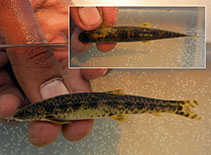| Diagnosis: |
Dorsal spines (total): -0; Dorsal soft rays (total): 11; Anal spines: -0; Anal soft rays: 9; Vertebrae: 39. Diagnosis: body depth 6.4-7.1 times in SL; head length 3.8-4.3 times in SL; snout rounded, its length 2.5-2.9 times in HL; eye superolateral, its diameter 5.1-5.5 times in HL, 1.4-1.7 times in interorbital distance, 1.8-2.1 times in snout length; dorsal fin origin about 1.1 times further from snout tip than from caudal fin origin; anal fin origin 1.4-1.6 times further from pelvic fin origin than from caudal fin origin; pectoral fin large, its length 4.9-5.4 times in SL, 0.7-0.9 times length of head; pelvic fin 6.4-7.1 times in SL, 1.5-1.7 times in HL; caudal peduncle 1.7-1.9 times as long as deep (Ref. 89136).
Description: mouth inferior; lower lip absent, but cutting edge present on lower jaw; scales very small; caudal fin with 19 soft rays, deeply forked, its lower lobe a little longer than the upper (Ref. 89136). Details on the morphology/anatomy of the gills, intestines and swim bladder can be found in Ref. 89077, details on the morphology/anatomy of skull, branchial skeleton, axial skeleton, dorsal and anal fin skeleton, and pectoral and pelvic girdles can be found in Ref. 89082.
Coloration: ground color yellowish; mediolateral band made up of about a dozen large, oval spots, dorsally more or less alternating with smaller spots and a series of mediodorsal spots; head dark ventrally; fins greyish, caudal fin with 3 bands on each lobe (Ref. 89136). |
